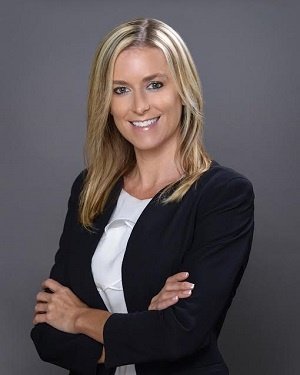 In this Workplace Unplugged interview, we sat down with Ingrid Fenn, Co-founder of SIREAS. A global real estate strategist and portfolio platform builder, Ingrid shares her experience helping clients develop strategies to manage their real estate and facilities organizations most effectively. SIREAS supports clients across all aspects of commercial real estate from strategic portfolio planning, facilities management, workplace transformation, portfolio management, the real estate implications of M&A transactions, contract negotiations and vendor management and much more.
In this Workplace Unplugged interview, we sat down with Ingrid Fenn, Co-founder of SIREAS. A global real estate strategist and portfolio platform builder, Ingrid shares her experience helping clients develop strategies to manage their real estate and facilities organizations most effectively. SIREAS supports clients across all aspects of commercial real estate from strategic portfolio planning, facilities management, workplace transformation, portfolio management, the real estate implications of M&A transactions, contract negotiations and vendor management and much more.
Ingrid has more than a decade of multinational corporate real estate and facilities management expertise. From serving as Global Head of Real Estate for health products leader Covidien to integrating an international real estate strategy with business unit planning for Fortune 100 multinational United Technologies Corporation – Ingrid has a depth of expertise in strategic CRE and FM. We asked Ingrid to share her background and share her story of what led her to co-found SIREAS.
IF: I came from, educationally, a financial background. I have a masters in finance, and I started my real estate career at United Technologies. I joined the firm very young and I was with them for about 11 years – the last six or so within the real estate organization. UTC has over a hundred million square feet across <5000 locations. When I joined the real estate group I was managing the lease admin department originally and we ended up outsourcing the function to a 3rd party provider in the Philippines. After that happened, I moved into managing different regions of the account. Most recently, prior to co-founding SIREAS, I was head of real estate for Covidien, which is a global medical device company based outside of Boston, where I was responsible for their global real estate and facilities portfolio.
My partner, Michelle Flynn, had been a mentor and colleague of mine in the industry for many years. She founded the company in 1997, formally called Expense Management Solutions. We rebranded as SIREAS when I bought half the firm two years ago. Expense Management Solutions was one of the first real estate and facilities advisory firms in the industry and Flynn is a pioneer of many of the real estate models most relevant in the market today.
SIREAS works with clients to design and drive strategies that deliver meaningful savings, organizational and service delivery performance, and shareholder value for CRE organizations on a global scale. We asked Ingrid to tell us more about SIREAS and what makes her company stand out from other CRE advisory firms.
IF: What we do is a pretty niche market. We provide advisory services to global organizations around how they think about managing their real estate and facilities services more strategically from the perspective of people, process, technology and cost. How is your real estate organization structured,? What are your processes,? What is the cost of maintaining all of your facilities today, and what technologies are you using to help manage that space? We also help our clients determine the best way to deliver the services, i.e. with internal resources or through the support of external service providers. In addition to the internal strategic support we provide our clients, SIREAS does a lot of work around helping companies develop sourcing and go-to-market strategies relating to the delivery of real estate and facilities services. What sets us apart from our competition is that everyone who works for the firm has spent time managing real estate portfolios on the client side. Having that hands on experience helps us to truly understand the challenges our clients are facing and political landscapes that they are navigating. I guess you could say we speak their language.
SIREAS is a Certified Centre of Excellence for Vested®, a methodology for creating highly collaborative business relationship. We asked Ingrid to tell us what that entailed.
IF: SIREAS is the only real estate and facilities advisory form to be a Vested Center of Excellence. Vested is a business model, methodology, mindset and movement for creating highly collaborative business relationships that enable true win-win relationships in which both parties are equally committed to each other’s success. When applied, a Vested approach fosters an environment that sparks innovation, resulting in improved service, reduced costs and value that didn’t exist before — for both parties. Vested is based on award-winning research conducted by the University of Tennessee College of Business Administration and funded by the U.S. Air Force. SIREAS is a Certified Deal Architect and Center of Excellence for Vested, which means that we have the training and certification to advise our clients through a Vested deal. Now, I want to be very clear about this because SIREAS uses a number of different sourcing strategies and Vested is one of them. Vested is a great strategy, but it’s not necessarily the right strategy for every company, it really depends on the maturity of the organization and many other factors. So, what it means to be a Vested Centre of Excellence is that we can do Vested deals and we can lead our clients through Vested deals and work with them to transition from different sourcing relationships to a Vested model when it is appropriate.
With more than a decade of experience in corporate real estate and FM, Ingrid tells us about the biggest changes she has seen in the industry over the past ten years.
IF: Definitely the centralization of the function has become more and more prevalent. Historically, organizations managed their real estate in a very decentralized fashion. Over the last 10-15 years, organizations that are able to manage real estate portfolios across all of the different service lines have emerged. What I mean by that, is before there were just brokerage firms that were able to do real estate transactions, and project management firms that just did project work, and facilities maintenance firms that just did maintenance; now there are large, global organizations who manage across all of these different service lines and also across all of the different regions of the globe. Their ability to leverage economies of scale has substantial impact on their buying power. They’re managing billions and billions of square feet of real estate and their clients can use that to capitalize on savings relative to sourcing relationships, expertise and buying power. If an organization is sourcing in silo, they’re really only using the economies of scale within their own portfolio, or even less than that, doing it on a localized level and then they’re not taking advantage of any economies of scale at all.
Over the past five years, the service delivery models of these organizations has matured substaintially, as well as their ability to deliver these services globally. Advances in technology have also had a huge impact. Before, real estate organizations were managing their portfolios on Excel spreadsheets or “home-grown” systems, and now there are many different tools and technologies to track almost every single aspect of CRE and FM. This has been a big game changer in the industry.
In addition to that, from the corporate side, organizations are becoming increasingly more aware of what real estate is, and the impact it has on the organization. Twenty years ago there wasn’t even a central real estate organization within most companies and today that is certainly more the norm now. It didn’t tend to be on the radar of the C-suite because the spend was so decentralized and lost and in different cost allocation “buckets” at the local level. Today, I believe real estate and facilites management is much more critical to organizations as they realize the importance of the workplace from a cultural, branding and talent retention perspective, as well as the substantial financial impact their portfolios have on the bottom line. As companies are fighting to maintain competitive advantage in the marketplace, they have to look at departments, like real estate, that are not profit centres. Having the ability to be as efficient as possible and reduce cost, while still providing quality workplaces for employees – that has become very important.
Talent retention has become a huge factor that impacts real estate and facilites’ decision making and investment. Historically, the competition around talent wasn’t there like it is today. Organizations are realizing that they have to provide quality services to their employees in order to maintain that competitive advantage. In addition to location strategy, i.e. city centers vs. rural areas, the design of the workplace and the services provided to employees has become increasingly more critical. If you think about technology companies, i.e. the “Google’s” of the world, the competition for talent is fierce and you see this reflected in the office space and in the branding of the company from a real estate perspective. Companies are really starting to look at how their real estate and how their offices impact talent retention and workplace efficiency. If organizations are going to spend so much money on real estate, they want to ensure their employees actually want to come to work, and that their workspaces foster efficiency. Real estate is truly an investment in talent.

What mistakes do you often see facilities managers make when outsourcing and what advice do you have to overcome these mistakes?
IF: Facilities managers typically don’t drive the strategy, that’s usually done at a more senior level – the head of real estate for example. Outsourcing of facilities management can sometimes require a “lift and shift” of employees. Meaning, employees that used to work for the company internally, may now be working for the service provider the services were outsourced to. Of course, whenever there are changes that impact people, it becomes very sensitive and challenging to manage. It is not uncommon to see some push back on the facilities side.
When I was head of real estate for Covidien, the company, from a facilities management perspective, was operating in a completely decentralized model. FM wasn’t being run through the real estate organization, but rather, each local business was managing their own facilities. There was no standardization across the porfolio and there was no regional or global contract in place with a single external service provider. When we decided to centralize and outsource the delivery of facilities management, we spent about a year prior to going to market to build the relationships internally with our VPs of operations, facilities managers, engineers, and everyone else who would be impacted by the change. We put a tremendous amount of effort into giving them confidence that we knew what we were doing and confidence in the external providers’ ability to deliver the services. This was particularly important in the manufacturing environment. Covidien had a substantial manufacturing portfolio, which many felt increased the risk of outsourcing. Some of the risk was perceived from poor experiences in the past and some of it was real – pertaining to regulated environments, etc. We spent a significant amount of time educating the organization on service provider capabilities and the benefits of the initiative. Additionally, the change management program we put in place was critical for success. Effective communication and thoughtful planning are essential when executing on complex initiatives like this, particularly where so many people are impacted.
Reading through SIREAS’s thought leadership, we came across an interesting piece on the critical aspects of a good governance. Ingrid tells us more about why good governance is important and how CRE and FM organizations can implement good governance to ensure outsourcing success.
IF: I think a lot of organizations, when they go to outsource, focus their energy on the go-to-market strategy and contract negotiation but forget about transition and the go-forward governance structure. Developing that governance and really thinking about it and working together with the service provider to understand and agree upon what that’s going to be, is so important to the relationship and success moving forward. What I mean by that is, you want to understand and mutually agree on what the desired outcomes are going to be. What is it that you want from your service provider, how do you want them to manage the account and what does success look like for both of the organizations. The governance piece is about how you manage and measuring success. You can’t just jump into the relationship without setting up a good governance structure beforehand, without expecting a lot of finger pointing as soon as something goes wrong. Good governance, good structure, and good communication really lay the groundwork for innovation. If you don’t have that, and the teams are not communicating together, they won’t necessarily understand where the pitfalls are in order to resolve them in innovative ways.
We asked Ingrid to look into her crystal ball and tell us what she sees being the biggest change or trend on the horizon in CRE and FM.
IF: Technology. I continually see some really cool and amazing new technologies coming out to help manage facilities and I think that’s only going to become better and better over the next five to ten years. There is an astounding amount of new technology out there and I think it will be really interesting to see where that goes in the next five to ten years.
To learn more about best practices in strategic international real estate, follow SIREAS on their blog, or reach Ingrid directly at [email protected].
How does your organization manage the number of vendors you work with for your real estate and facilities? Is your strategy currently decentralized? Share your approach in the comments below!
Photos: Jesse Orrico, Breather, Oliver Klein, Nuno Silva





